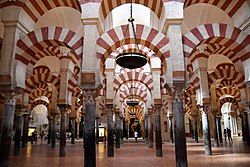
Back عمارة إسلامية Arabic عماره اسلاميه ARZ İslam memarlığı Azerbaijani Мосолман архитектураһы Bashkir Ісламская архітэктура Byelorussian Ислямска архитектура Bulgarian ইসলামি স্থাপত্য Bengali/Bangla Islamska arhitektura BS Arquitectura islàmica Catalan نژیاروانیی ئیسلامی CKB
Top: arches of the Mosque–Cathedral of Córdoba (Spain); centre: the Jameh Mosque in Isfahan (Iran); bottom: interior side view of the main dome of the Selimiye Mosque (Edirne, Turkey) |
Islamic architecture comprises the architectural styles of buildings associated with Islam. It encompasses both secular and religious styles from the early history of Islam to the present day. The Islamic world encompasses a wide geographic area historically ranging from western Africa and Europe to eastern Asia. Certain commonalities are shared by Islamic architectural styles across all these regions, but over time different regions developed their own styles according to local materials and techniques, local dynasties and patrons, different regional centers of artistic production, and sometimes different religious affiliations.[1][2]
Early Islamic architecture was influenced by Roman, Byzantine, Iranian, and Mesopotamian architecture and all other lands which the early Muslim conquests conquered in the seventh and eighth centuries.[3][4][5][6][7] Further east, it was also influenced by Chinese and Indian architecture as Islam spread to South and Southeast Asia. Later it developed distinct characteristics in the form of buildings and in the decoration of surfaces with Islamic calligraphy, arabesques, and geometric motifs.[8] New architectural elements like minarets, muqarnas, and multifoil arches were invented. Common or important types of buildings in Islamic architecture include mosques, madrasas, tombs, palaces, hammams (public baths), Sufi hospices (e.g. khanqahs or zawiyas), fountains and sabils, commercial buildings (e.g. caravanserais and bazaars), and military fortifications.[2]
- ^ Tabbaa, Yasser (2007). "Architecture". In Fleet, Kate; Krämer, Gudrun; Matringe, Denis; Nawas, John; Rowson, Everett (eds.). Encyclopaedia of Islam, Three. Brill. ISBN 9789004161658.
- ^ a b Bloom & Blair 2009, "Architecture".
- ^ Petersen 1996, p. 295: "As the Arabs did not have an architectural tradition suited to the needs of a great empire, they adopted the building methods of the defeated Sassanian and Byzantine empires. Because they ruled from Syria, Byzantine influence was stronger, although Sassanian elements became increasingly important."
- ^ Ettinghausen, Grabar & Jenkins-Madina 2001, p. 7.
- ^ M. Bloom, Jonathan; S. Blair, Sheila, eds. (2009). "Architecture". The Grove Encyclopedia of Islamic Art and Architecture. Oxford University Press. pp. 74, 78. ISBN 9780195309911.
Although Syria remained the center of the Islamic empire for less than 90 years, its role in the development of Islamic architecture was crucial. The region's own ancient civilization, unified and transformed by Hellenization and overlaid with Roman and Christian elements, provided the basis for the new architectural style. The forms and conventions of Classical architecture were better understood in Syria than in the lands further east, and as a result some of the vocabulary of Umayyad architecture—of column and capital, pointed arch and dome, rib and vault—is familiar to a Western observer. These traditions declined in importance, however, as Muslim builders began to adopt the architectural styles of the newly conquered lands to the east—in Mesopotamia, Iran, Central Asia and even India. (...) The Abbasid dynasty of caliphs, founded in 749, ruled most of the Islamic lands from capital cities in Iraq during a golden age that lasted at least until the end of the 9th century. New styles of architecture were characterized by forms, techniques and motifs of Iraqi and Iranian origin. Some features of these styles, such as brick vaults and stucco renderings, had already appeared in buildings erected late in the Umayyad period (661–c. 750; see §III above), but they became increasingly widespread as a result of the power and prestige of the Abbasid court. In the Islamic lands around the Mediterranean, Late Antique traditions of stone construction roofed with wood continued, although new techniques and styles were eventually introduced from Iraq.
- ^ Grabar, Oleg (2011). "Art and Culture in the Islamic World". In Hattstein, Markus; Delius, Peter (eds.). Islam: Art and Architecture. h.f.ullmann. pp. 36–37. ISBN 9783848003808.
At this stage of scholarly knowledge, however, it is probably fair to say that Islam's Arabian past, essential for understanding the faith and its practices, and the Arabic language and its literature, is not as important for the forms used by Islamic art as the immensely richer world, from the Atlantic Ocean to Central Asia, taken over by Islam in the 7th and 8th centuries. Even later, after centuries of independent growth, new conquests in Anatolia or India continued to bring new local themes and ideas into the mainstream of Islamic art.
- ^ Flood & Necipoğlu 2017, p. 30, Frameworks of Islamic Art and Architectural History: Concepts, Approaches, and Historiographies: "Thus, it is increasingly being recognized that the mutual Roman–Byzantine architectural heritage of the Mediterranean, which had played an important role in the formation of early Islamic art, continued to mediate the shared histories of European and Islamic art long after the medieval period."
- ^ Bloom & Blair 2009, Ch.s "Architecture", "Ornament and pattern".
© MMXXIII Rich X Search. We shall prevail. All rights reserved. Rich X Search


